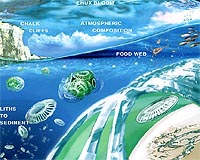| . |  |
. |
Madrid, Spain (SPX) Jun 05, 2009 "Anybody who observes waves can see that they are not the same height in winter and summer, but rather that their height varies over time, and we have applied a 'non- seasonal' statistical model in order to measure extreme events such as these", Fernando J. Mendez, an engineer at the Institute of Environmental Hydraulics at the University of Cantabria and co-author of a study published recently in the journal Coastal Engineering, tells SINC. The new model can chart the pattern of extreme waves "with a greater degree of reliability", by studying 'significant wave height' (Hs) in relation to a specific return period. The Hs is the representative average height of the sea, provided by buoys (it is calculated by measuring one in three of the highest waves), and the return period is the average time needed for the event to happen. For example, if a wave height of 15 metres is established at a certain point on the coast with a return period of 100 years, this means that, on average, a wave of 15 metres could reach this point once every 100 years. "This can be very useful when it comes to building an oil platform in the sea or a particular piece of coastal infrastructure", explains Mendez. The researchers have used data recorded between 1984 and 2003 by five coastal buoys located near the cities of Bilbao, in Vizcaya; Gijon, in Asturias; La Coruna, C�diz and Valencia in order to demonstrate the validity of their model. The results show that extreme Hs values vary according to location and the month of the year.
The meteorological component of extreme waves The period of large waves in La Coruna extends from October to April, because of the city's westerly position and resulting exposure to more prolonged winter storms. The Atlantic coast of C�diz, meanwhile, reflects the characteristic calm of this area of sea between July and September, with Hs values below two metres. The figures for December and January, however, can vary a great deal from one year to another, reaching wave heights in excess of six metres. Waves on the Mediterranean coast at Valencia measure between 3 and 3.5 metres from September until April, although the graphics reveal two peaks during this period, one of which coincides with the start of spring and the other with the autumn months, during which the phenomenon of the gota fr�a occurs. (Gota fr�a events are atmospheric cold air pools that cause rapid, torrential and very localised downpours and high winds). "All these data are of vital importance in terms of coastal management, since they can establish the risk of flooding and are indispensable for the carrying out of marine construction work, for example infrastructure built close to the coast", Melisa Menendez, another of the study's authors, tells SINC. "In addition, they make it possible to calculate the likelihood of a maritime storm occurring". The researcher also stresses that this information could be very useful in helping to better understand some biological processes, such as how the distribution of marine animals is affected by wave swell, and seaweed growth rates, as well as geological processes, such as how particulates and sediments are transported along the coast.
Extreme value theory The latest advances in this field have made it possible to better study climatic variability at various scales - over a year (seasonality), over consecutive years or decades (which allows climatic patterns to be derived), and over the long term (providing trends). The study into extreme waves is on the seasonal scale, but the team has also studied extreme sea level values over almost a 100-year period, thanks to data gathered during the 20th Century by a mareograph located in Newlyn, in the United Kingdom. The scientists have already started to obtain information about extreme swell and sea level values at global level as part of a United Nations project to study the sea's impacts on coasts all over the planet, and how these affect climate change. Share This Article With Planet Earth
Related Links FECYT - Spanish Foundation for Science and Technology Water News - Science, Technology and Politics
 Climate talks must tackle ocean acidification: scientists
Climate talks must tackle ocean acidification: scientistsParis (AFP) June 1, 2009 The world's top scientific academies on Monday called on UN talks to include ocean acidification, a dangerous byproduct of carbon pollution, in a global treaty to tackle climate change. "Ocean acidification is expected to cause massive corrosion of our coral reefs and dramatic changes in the makeup of the biodiversity of our oceans and to have significant implications for food production and ... read more |
|
| The content herein, unless otherwise known to be public domain, are Copyright 1995-2009 - SpaceDaily. AFP and UPI Wire Stories are copyright Agence France-Presse and United Press International. ESA Portal Reports are copyright European Space Agency. All NASA sourced material is public domain. Additional copyrights may apply in whole or part to other bona fide parties. Advertising does not imply endorsement,agreement or approval of any opinions, statements or information provided by SpaceDaily on any Web page published or hosted by SpaceDaily. Privacy Statement |